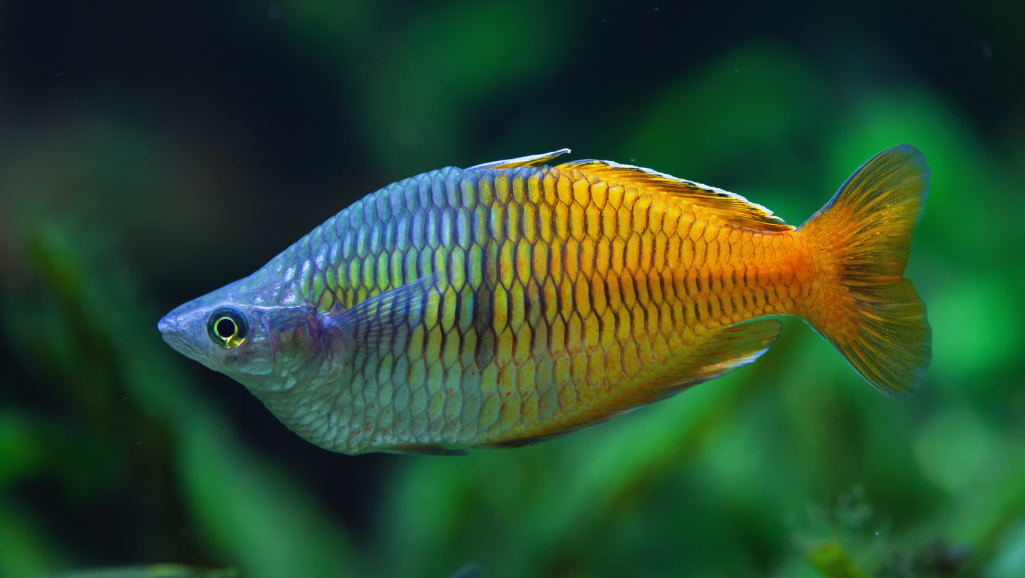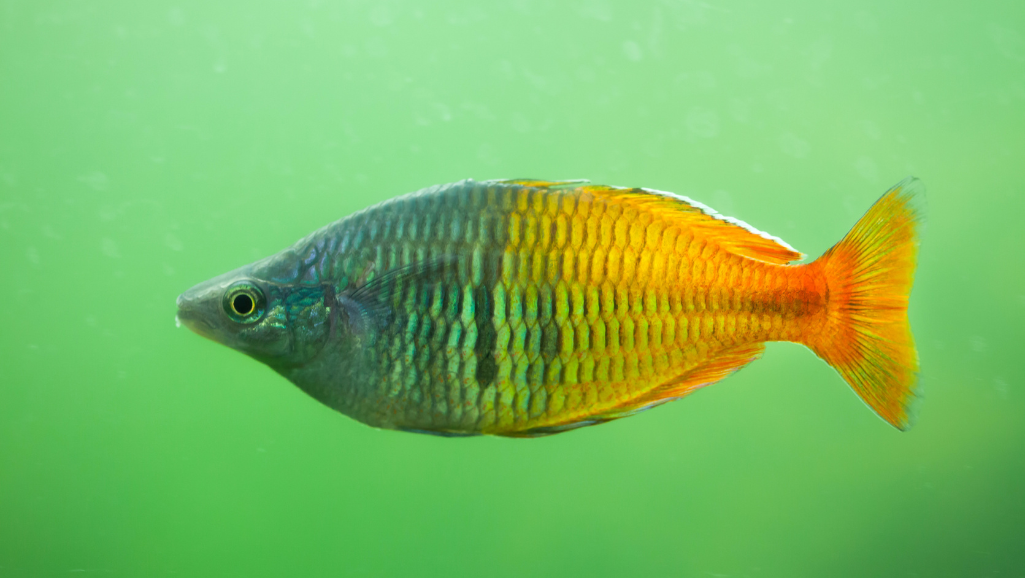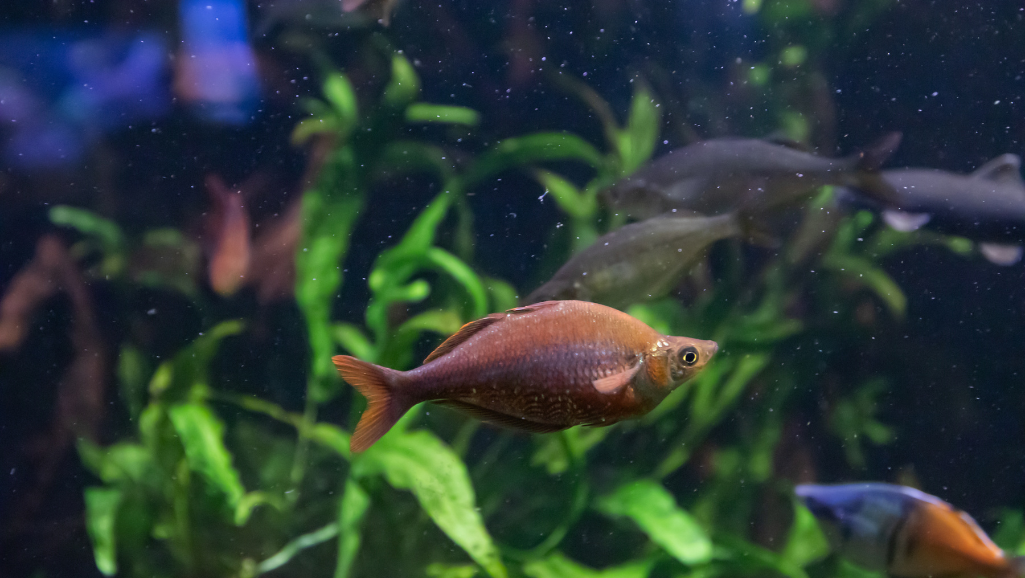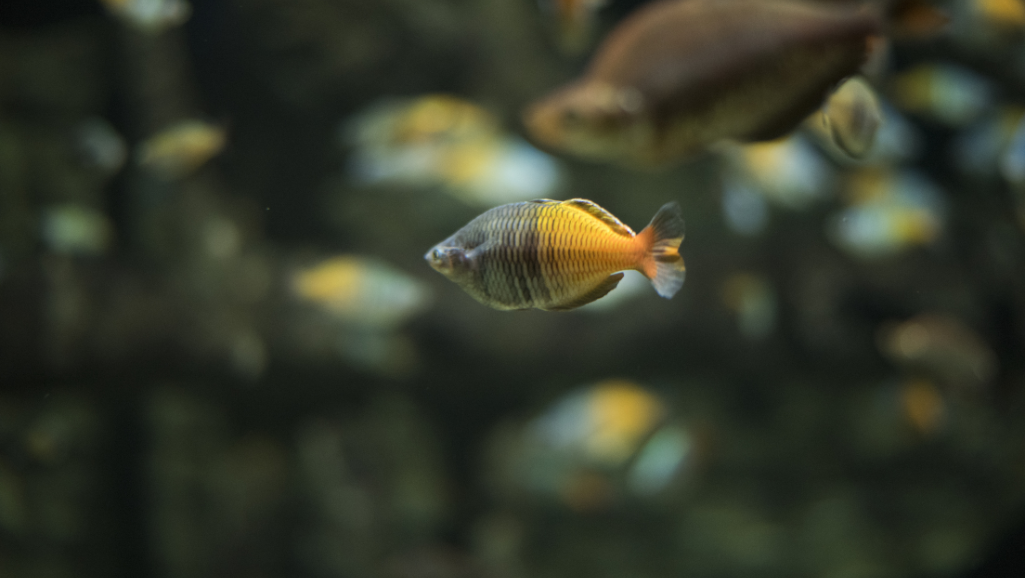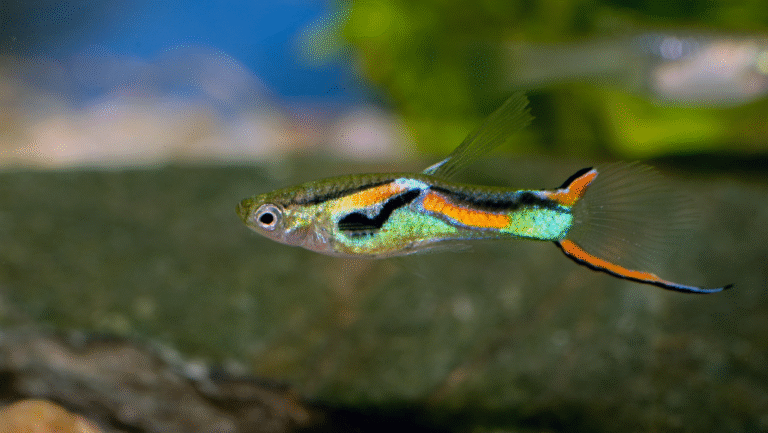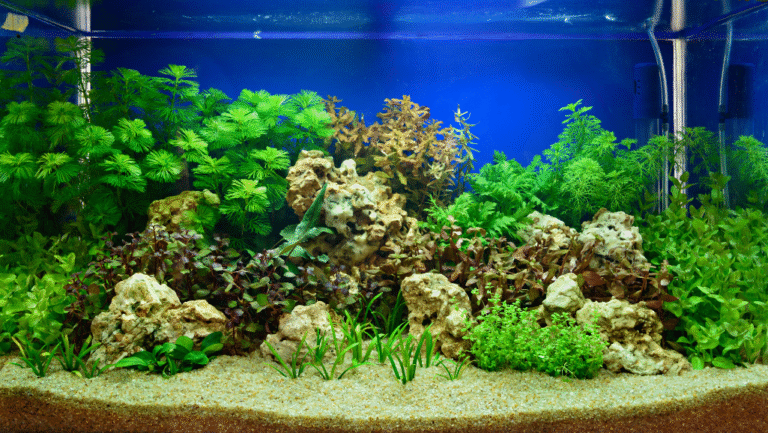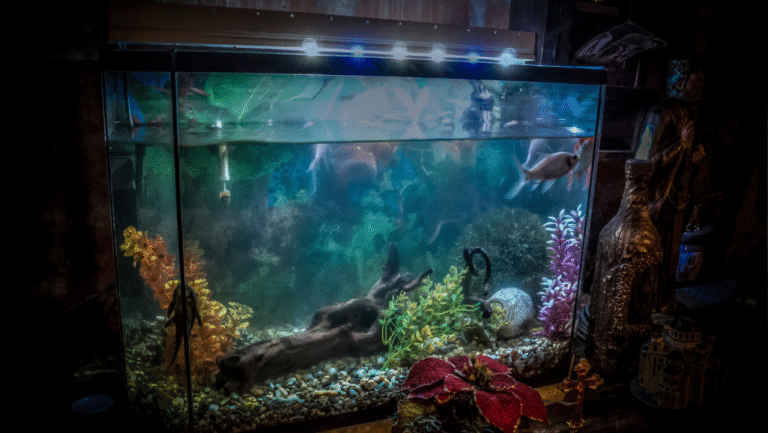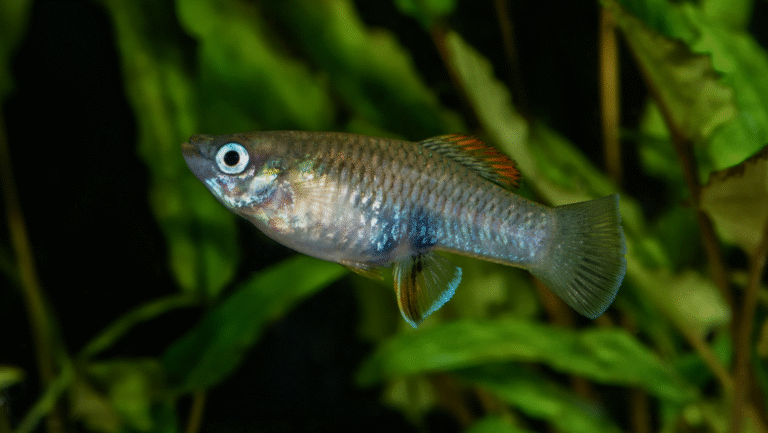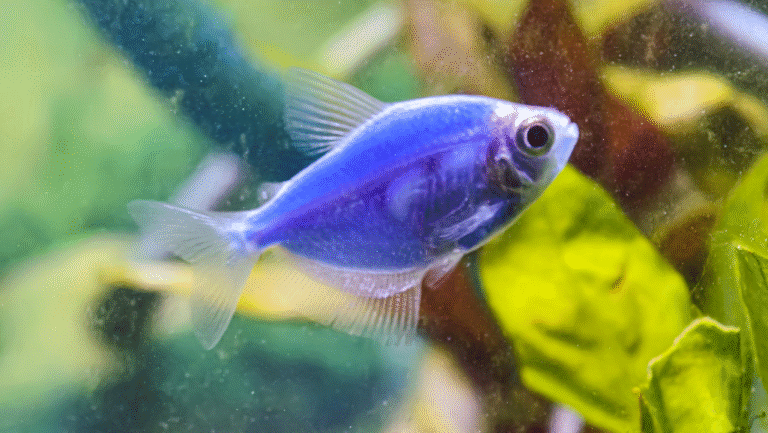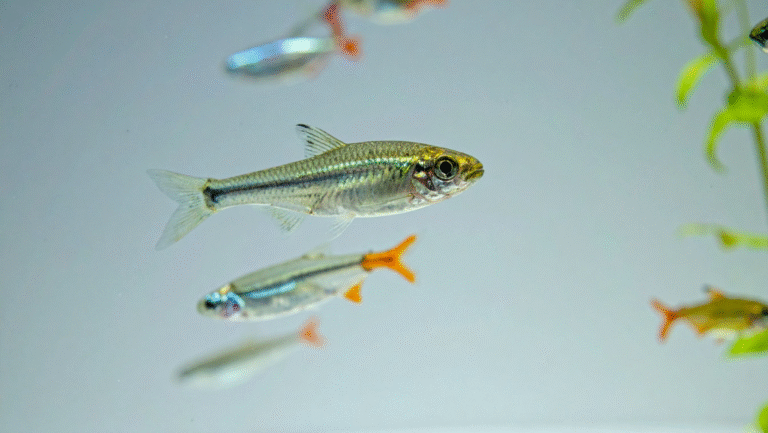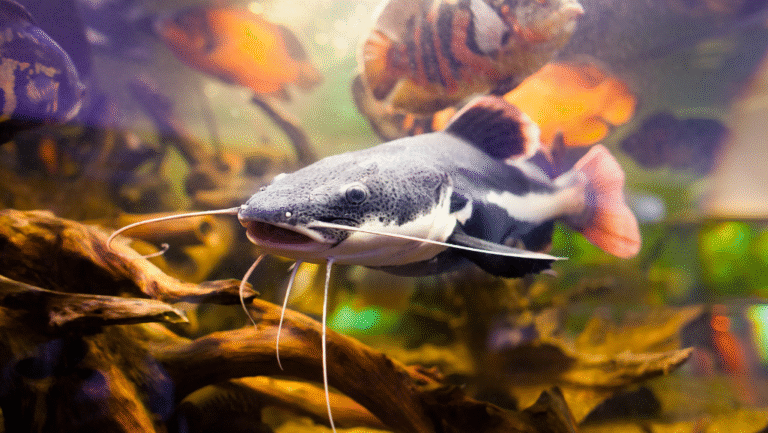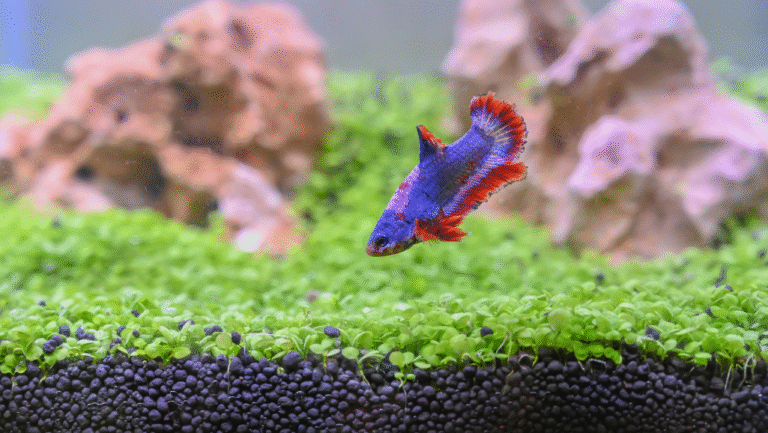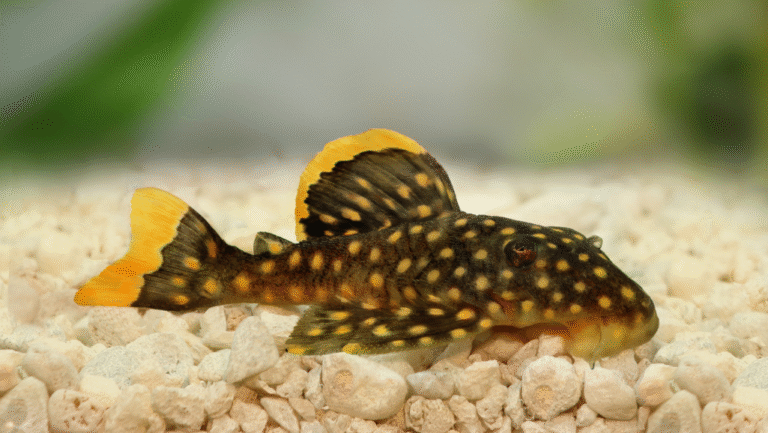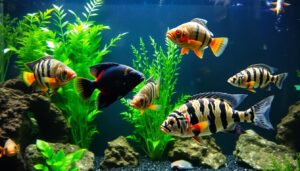Madagascar Rainbowfish — a shimmering schooling species that brings river light into your home. This lively rainbowfish thrives in clear, shaded streams and lower river reaches, and it shows its best colors when kept in a proper school.
In nature, groups move in sync through tannin-stained, softly flowing waters. In the aquarium, a long footprint, dense planting, driftwood, and spotless, oxygen-rich water unlock peak color and vigor.
Know the scientific order and correct name to avoid trade mix-ups: accurate identification protects wild lineages and ensures proper care. Focus on stable temperature, pH, and routine water management so lifespan and coloration remain strong. Thoughtful stocking and habitat mimicry turn a tank into a living ribbon of motion.
Key Takeaways
- Keep madagascar rainbowfish in lively schools to reveal natural behavior and color.
- Provide a spacious tank (120 x 30 cm or larger) with rich planting and open midwater lanes.
- Maintain pristine, oxygen-rich water with regular changes (see Quick-Start checklist).
- Mimic shaded, soft-water nature for best health and display.
- Confirm the species’ order and name before buying to avoid hybrids and support ethical sourcing.
Set Your Vision: A How-To Guide to a Thriving Madagascar Rainbowfish Aquarium
Picture a long, planted aquarium where a lively school of madagascar rainbowfish moves with the calm rhythm of shaded streams. Start with a 120 x 30 cm base (4 ft) or larger so active fish can cruise and display their colors across open midwater lanes.
Essentials: equipment and core targets
Focus on stable conditions: strong oxygenation, clean soft water, and steady parameters. Aim for a stable temperature near 22–25°C, gentle flow from a reliable filter, and consistent weekly water changes to keep chemistry even.
- Filtration: a canister or hang-on-back with a turnover of ~6–8× tank volume per hour, plus a sponge prefilter for fry safety.
- Oxygenation: moderate surface agitation and live plants to support high dissolved oxygen.
- Substrate & hardscape: fine substrate, driftwood, and leaf litter to release mild tannins and create microhabitats.
Aquascape and stocking
Build an aquascape of dense plants, driftwood, floating cover, and leaf litter to reduce stress and let the species behave naturally in groups of 8–10+. Prioritize length over height so schools can form and move in steady lanes.
Feeding basics
Feeding blends staples and treats: anchor daily feeding with quality flakes or micro-granules (small flakes), and rotate live or frozen foods such as Daphnia, Artemia, and bloodworms several times weekly to condition fish for breeding and keep colors vivid.
Quick-Start Checklist: From Empty Tank to Active School
Begin with the essentials: confirm a 120 x 30 cm (4 ft) footprint or larger, reliable filtration, and dechlorinated water. Set tank temperature to 22–25°C and verify key water parameters (pH, hardness, ammonia/nitrite/nitrate) before stocking.
“A well-planned start makes healthy, colorful schools possible.”
- Cycle fully; introduce fish only when ammonia and nitrite read zero.
- Stock groups of 8–10+ to reduce hierarchy stress and encourage bold displays.
- Quarantine newcomers for at least 10–14 days to protect your display and avoid hybrid or disease risks.
- Plan weekly water changes (see Water Parameters section for recommended volumes) to keep conditions spotless and oxygen-rich.
- Feed quality staples daily (small flake or micro-granules) and rotate live or frozen foods like Daphnia, Artemia, and bloodworms several times weekly.
- Prepare a simple spawning kit (fine plants or mops). If you collect eggs, expect hatching in about 7–10 days under stable temperatures; have infusoria or liquid fry foods ready for the first feeds.
- Log temperature and tests; change parameters slowly to avoid shock to adults and fry.
- Maintain filter care and surface cleaning to keep dissolved organics low and oxygen high.
Follow this checklist and you’ll move from empty glass to a thriving, colorful school with fewer surprises. For a printable starter checklist, see the Quick-Start anchor above and link into the Breeding and ID sections for next steps.
Madagascar Rainbowfish
A clear ID and origin story guide better husbandry and protect genetic integrity.
Scientific name, origin, and conservation status
Common name / Scientific name: Madagascar Rainbowfish — Bedotia madagascariensis (described 1903). Order: Atheriniformes. Family: Bedotiidae. Conservation: localized range; verify current IUCN status when sourcing.
The natural habitat is small, shaded streams and lower river reaches in the Atsinanana region of eastern Madagascar, including waterways connected by the Canal des Pangalanes. These tannin-stained, slow-flowing corridors shape the species’ behavior and aquarium needs.
Note: trade records sometimes misidentify this species as Bedotia geayi. To avoid hybridization and protect wild genetics, check sellers for captive-bred provenance and look for distinguishing features (male fin pigment and subtle scale patterning) when possible.
Size, lifespan, and temperament at a glance
Expect a modest adult size: many scientific sources list a standard length around 80–100 mm, while hobby observations occasionally report larger totals—verify reported sizes from breeders. Adults are peaceful, schooling fish best kept in groups of 8–10 or more to reduce stress and showcase natural behaviors.
- Males are typically more ornamented, with stronger fin pigmentation and brighter hues.
- Females tend to be rounder-bodied with subtler coloration.
- Look for spawning behavior in planted or mop setups; confirm egg presence and consult the Breeding section before attempting to raise fry.
Understand Their World: Natural Habitat and Behavior in Madagascar
Narrow, tree-lined waterways set the stage for much of this species’ daily life. The natural habitat is typically tea-stained, softly flowing streams and calm lower rivers that drain to coastal lakes and lagoons in the Atsinanana range.
Riparian vegetation casts shade and slows flow; those cues reduce stress and let groups form into schools that may number many individuals. Recreating shade and tannin-rich cover in the aquarium invites similar schooling behavior.
Clear, shaded streams, rivers, and coastal lakes of the Atsinanana region
Many local waters are very soft and tannin-rich—blackwater conditions occur in places. Seasonal connectivity (for example via the Canal des Pangalanes) can link populations and influence local movements.
Schooling nature: juveniles in shallows, adults in deeper waters
In the wild, juveniles often hug protected margins while adults cruise deeper channels. This life-stage partitioning reduces predation risk and helps preserve fin condition and color in adults.
“Clarity and shade are survival factors — recreate them and you invite natural behavior and calmer displays.”
- Recreate shaded cover with floating plants and leaf litter to mimic natural microhabitats.
- Avoid bright, unshaded tanks that favor fast-moving livebearers and stressed fish.
- Think in terms of flowing rivers when planning tank flow and sightlines.
Use these habitat cues—soft, slightly tannin-stained water, shaded edges, and open midwater lanes—to guide your Tank Setup and Water Parameters choices for a natural, comfortable home for the madagascar rainbowfish.
Tank Setup That Mirrors Nature
Design the tank to mirror river corridors so schools of madagascar rainbowfish can swim with effortless grace.
Start with the right base: choose a 120 x 30 cm or larger footprint so active swimmers have real length and room to form steady schools. Size and length matter more than height for natural movement and comfortable schooling.
Aquascape essentials
Lay heavy planting and driftwood roots to create corridors and sight breaks. Add floating vegetation and a thin layer of leaf litter to soften light and release mild tannins—these elements reduce stress and emulate their riverine nature.
Flow and filtration
Pick a filtration system that delivers gentle current with high oxygen transfer (aim for ~6–8× turnover per hour), and include a sponge prefilter if you plan to keep fry. Keep water clean—this species fares best with low organics and regular maintenance; plan weekly changes tailored to stocking and bioload.
- Must-have: long footprint, reliable filtration, and stable temperature control.
- Nice-to-have: leaf litter, Indian almond or beech leaves, floating cover, and driftwood for microhabitats.
- Substrate: fine-grained material that won’t trap debris and displays natural colors.
“Clean, oxygen-rich conditions bring out color and calm behavior.”
These choices build an aquascape that supports behavior and quality of life for the madagascar rainbowfish while making a graceful, living display in your aquariums.
Dialing in Water Parameters for Peak Color and Health
Good aquarium color begins with steady, predictable water chemistry. Consistency matters more than chasing extremes: small, steady gains in clarity and chemistry produce big visual and health returns for your madagascar rainbowfish.
Recommended targets (quick reference)
Temperature: 22–25°C (72–77°F) — keep day-to-day stability to protect metabolism and color.
pH: target 6.0–7.5 in most aquariums (wild waters can be lower—4.5 in blackwater pockets); avoid rapid swings.
Hardness / TDS: favor soft to moderately soft water; aim for low TDS (under ~150 ppm) and GH/KH on the lower side depending on your source water.
Soft, clean freshwater and the role of tannins
Favor clean, soft water. Mild tannins from botanicals (Indian almond leaves, beech leaves, driftwood) lower pH slightly, reduce light intensity, and help calm behavior—many hobbyists report richer coloration in tannin-tinged setups. Botanicals also support a balanced micro-ecosystem when used sensibly.
Stability strategies: testing cadence and adjustment tips
Test core water parameters weekly at consistent times and log trends. When you need to adjust chemistry, change slowly: precondition replacement water, match temperatures, and make incremental corrections to avoid shock.
- Do: weekly logs of temperature, pH, ammonia, nitrite, and nitrate; weekly 30% routine changes as a baseline (adjust toward 30–50% depending on bioload).
- Don’t: make abrupt pH or temperature swings — these trigger stress and color loss.
- TDS control: use RO/DI mixing if your source water is hard; aim for a stable, modest TDS rather than chasing zero.
“Clear waters and steady chemistry bring out stronger schooling and richer display.”
If you encounter problems (fading color, clamped fins, or erratic schooling), check nitrogenous waste and oxygenation first, then review recent changes in water chemistry or flow. For busy keepers, consider a simple water-log template to track trends over time and catch drift before issues escalate.
Stocking Strategy: Groups, Sex Ratios, and Peaceful Tankmates
A thoughtful stocking plan makes the difference between a stressed community and a confident, colorful school. Size the tank for the whole group and any companions—not just a single show fish.
Why 8–10+ and a female-heavy balance work
Madagascar rainbowfish feel safest in numbers. Aim for groups of at least 8–10 individuals so each fish relaxes into schooling behavior; larger groups produce tighter formations and bolder color.
Prefer more females than males (for example 2–3 females per male) to reduce chasing and shift energy toward natural courtship rather than harassment—this improves welfare and lowers stress.
Compatible companions and hybrids to avoid
Choose calm midwater companions that match pace and parameters: other small rainbowfishes, peaceful characins, small barbs that aren’t fin-nippers, and peaceful catfishes or Corydoras can make good dither fish. Avoid other Bedotia species in the same tank to prevent unintended hybridization and protect lineage integrity.
- Use sightline-breaking aquascapes and shaded zones to diffuse male displays.
- Introduce newcomers slowly and quarantine for 10–14 days to reduce disease risk.
- Plan stocking so every individual has room to swim and hide—think community capacity, not headcount alone.
“Right numbers, thoughtful mates, and a roomy layout produce calmer behavior and brighter displays.”
Feeding for Brilliance: Daily Diets and Color-Boosting Foods
A varied, frequent diet brings out the best hues and energy in your school.
Staples: fine flakes and micro-granules
Anchor daily feedings with a quality small flake or micro-granule formulated for midwater tropicals. These foods provide baseline nutrition and are easy to portion for groups.
Live and frozen treats
Rotate live and frozen items—Daphnia, Artemia, and bloodworms are excellent. Incorporate frozen foods several times weekly to stimulate foraging, deepen color, and condition adults for breeding.
Frequency, portions, and water care
Feed small portions two to three times daily so the school consumes food within ~2 minutes. Remove uneaten food promptly to protect water quality and filtration.
- Staples daily; rotate live/frozen treats 2–4× weekly.
- Clear uneaten food within minutes to avoid nutrient spikes and algae problems.
- Increase live/frozen offerings when conditioning for breeding.
Tip: Mirror wild feeding patterns—light, frequent, and varied—to keep color saturated and behavior lively.
Water Quality Maintenance: Routine That Makes Colors Pop
Consistent maintenance keeps water pristine and the group showing its best hues.
Weekly water changes: volumes, technique, and timing
Start with weekly changes of ~30% as a baseline; increase toward 30–50% if stocking or feeding is heavier. Match temperature and chemistry of replacement water and dechlorinate before adding.
Vacuum gently around leaf litter and plants to remove detritus while preserving beneficial biofilms.
Filter care, oxygenation, and nitrate control
Service filters on a rotating schedule so beneficial bacteria remain intact; keep flow moderate and oxygenation high with surface agitation and plants. Track nitrate and respond with water changes and mindful feeding to keep levels safe and fins flawless.
“Steady routines yield steady results.”
- Log maintenance times and outcomes to spot trends.
- Check water clarity and parameters frequently after changes.
- Observe your fish for stress signs after maintenance or new additions.
Breeding and Spawning: Step-by-Step to Raise Fry
Use a compact, well-planted spawning tank to convert conditioning into reliable results. A 50–60 cm tank with fine-leaved plants (Java moss, Ceratophyllum) or floating nylon mops works well to collect eggs.
Conditioning adults and preparing the tank
Condition adults for 7–14 days with extra live and frozen protein. Use one male with two–three females to balance courtship and reduce harassment. Provide dense cover and low glare so females can rest between bursts of display.
Egg deposition and incubation timeline
Females deposit several eggs daily on plants or mops. Most clutches hatch in about 7–10 days depending on temperature—have infusoria or liquid fry foods ready for first feeds.
First foods, fry care, and early water cautions
Start fry on powdered infusoria or commercial liquid fry foods, then introduce Artemia nauplii after about a week. Fry are sensitive to fluctuations—keep chemistry stable and perform only small, careful changes if needed.
- Condition with live foods before moving breeders.
- Provide fine plants or mops for egg attachment and protection.
- Keep flow gentle and plenty of hiding spots for females and fry.
- Separate age groups to prevent competition as fry grow.
“Steady routines and timely foods give fry the best start.”
Health, Stress, and Behavior: Reading the Signs
Small changes in the display often show first in how your fish hold their fins and move as a group. Watch daily for faded color, clamped fins, or a school that tightens and bolts at minor disturbances—these are early warnings something in the tank needs attention.
Early indicators to act on
Spotting problems early lets you address root causes quickly. Color loss, fin clamping, and skittish schooling commonly point to poor water quality (organics, ammonia, nitrates), abrupt parameter swings, or overly strong flow.
Common pitfalls and fixes
- Organics buildup: Audit cleanliness and oxygenation first—perform a partial water change and vacuum debris; check filter flow and media.
- Group size: Keep at least 8–10 individuals; too few increases nervous behavior and chronic stress.
- Flow balance: Soften currents with plants and driftwood so fish can cruise without constant effort.
“Consistent, gentle care beats drastic changes every time.”
Keep routines steady: regular testing, measured tweaks, and separating vulnerable fry or recovering females when needed. If problems persist, quarantine suspicious newcomers and run focused tests for ammonia, nitrite, and nitrate.
Ethical Keeping: Wild Roots, Deforestation, and Responsible Aquarists
Conservation starts at the aquarium glass; the choices you make at home ripple back to rivers and streams in Madagascar.
These fish come from a narrow range of shaded, soft freshwater systems. Their survival depends on intact canopy and clean water provided by healthy forests—loss of shade raises temperature and favors invasives, which degrades native habitat.
- Mirror natural conditions in your aquarium—shade, soft water, and leaf litter help replicate wild cues.
- Choose correctly identified, preferably captive-bred stock to avoid hybridization and protect wild genetics.
- Support organizations that protect watersheds and reduce demand for wild-caught specimens.
“Every responsible setup becomes a small act of conservation when it mirrors natural conditions and supports ethical trade.”
Share best practices with other hobbyists—small actions (shade, soft water, correct sourcing) scale into real conservation outcomes.
Conclusion
When length, clean water, and gentle flow come together, the display becomes effortless. Give a long footprint, dense planting, and oxygen-rich circulation and you set the stage for confident schooling and bright color.
Keep a school of 8–10+ to foster calm interactions. Feed quality staples plus regular live or frozen treats and maintain routine maintenance (weekly water changes tailored to bioload) so health and hue last. For those ready to try breeding, use fine plants or mops, time feeds for conditioning, and handle fry with care and patience.
Let your aquarium be art and advocacy—an everyday reminder of why madagascar rainbowfish merit respect. With steady routines and simple gear, you’ll turn effort into reward: fish at their best, and time well spent.
